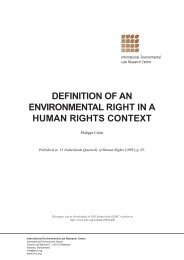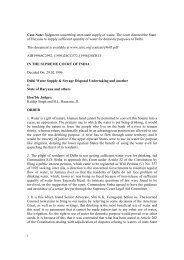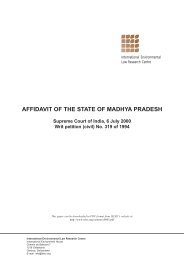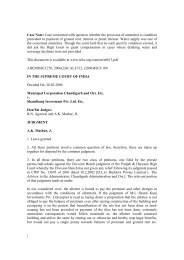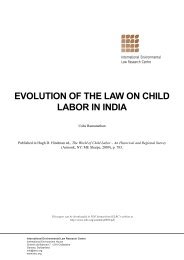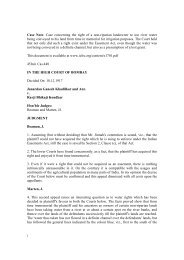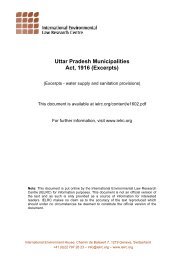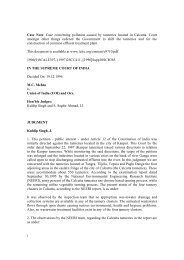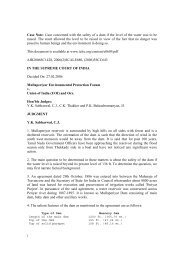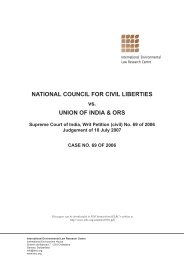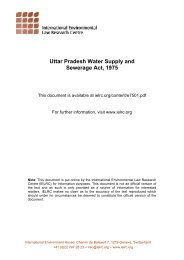Narmada Bachao Andolan vs. Union of India - International ...
Narmada Bachao Andolan vs. Union of India - International ...
Narmada Bachao Andolan vs. Union of India - International ...
Create successful ePaper yourself
Turn your PDF publications into a flip-book with our unique Google optimized e-Paper software.
MAJORITY JUDGEMENT[For the Minority Judgement, See page 59]32. Kirpal, J. (for himself and on behalf <strong>of</strong> Dr A.S. Anand, Chief Justice <strong>of</strong> <strong>India</strong>) (Majority view) <strong>Narmada</strong> is thefifth largest river in <strong>India</strong> and largest west-flowing river <strong>of</strong> the <strong>India</strong>n Peninsula. Its annual flow approximates tothe combined flow <strong>of</strong> the rivers <strong>of</strong> Sutlej, Beas and Ravi. Originating from the Maikala ranges at Amarkantak inMadhya Pradesh, it flows westwards over a length <strong>of</strong> about 1,312 km, before draining into the Gulf <strong>of</strong> Cambay, 50km west <strong>of</strong> Bharuch City. The first 1,077 km stretch is in Madhya Pradesh and the next 35 km stretch forms theboundary between the States <strong>of</strong> Madhya Pradesh and Maharashtra. Again, the next 39 km forms the boundarybetween Maharashtra and Gujarat and the last stretch <strong>of</strong> 161 km lies in Gujarat.33. The basin area <strong>of</strong> this river is about 1 lakh km². The utilisation <strong>of</strong> this river basin, however, is hardly about 4percent. Most <strong>of</strong> the water <strong>of</strong> this peninsula river goes into sea. Inspite <strong>of</strong> the huge potential, there was hardly anydevelopment <strong>of</strong> the <strong>Narmada</strong> water resources prior to independence.34. In 1946, the then Government <strong>of</strong> Central Provinces and Berar and the then Government <strong>of</strong> Bombay requestedthe Central Waterways, Irrigation and Navigation Commission (CWINC) to take up investigations on the <strong>Narmada</strong>River system for basin wise development <strong>of</strong> the river with flood control, irrigation, power and extension <strong>of</strong>navigation as the objectives in view. The study commenced in 1947 and most <strong>of</strong> the sites were inspected byengineers and geologists who recommended detailed investigation for seven projects. Thereafter in 1948, theCentral Ministry <strong>of</strong> Works, Mines & Power appointed an ad-hoc committee headed by Shri A.N. Khosla, Chairman,CWINC to study the projects and to recommend the priorities. This ad-hoc committee recommended as an initialstep detailed investigations for the following projects keeping in view the availability <strong>of</strong> men, materials and resources:1) Bargi Project,2) Tawa Projects near Hoshangabad,3) Punasa Project, and4) Broach Project.35. Based on the recommendations <strong>of</strong> the aforesaid ad-hoc committee, estimates for investigations <strong>of</strong> the Bargi,Tawa, Punasa (<strong>Narmada</strong>sagar) and Broach Projects were sanctioned by the Government <strong>of</strong> <strong>India</strong> in March 1949.36. The Central Water & Power Commission carried out a study <strong>of</strong> the hydroelectric potential <strong>of</strong> the <strong>Narmada</strong>basin in the year 1955. After the investigations were carried out by the Central Water & Power Commission, theNavagam site was finally decided upon in consultation with the erstwhile Government <strong>of</strong> Bombay for theconstruction <strong>of</strong> the dam. The Central Water & Power Commission forwarded its recommendations to the thenGovernment <strong>of</strong> Bombay. At that time the implementation was contemplated in two stages. In Stage-I, the FullReservoir Level (hereinafter referred to as ‘FRL’) was restricted to 160 ft with provision for wider foundations toenable raising <strong>of</strong> the dam to 300 ft in Stage II. A high level canal was envisaged in Stage-II. The erstwhile BombayGovernment suggested two modifications, first the FRL <strong>of</strong> the dam be raised from 300 to 320 ft in Stage-II andsecond the provision <strong>of</strong> a power house in the river bed and a power house at the head <strong>of</strong> the low level canal be alsomade. This project was then reviewed by a panel <strong>of</strong> consultants appointed by the Ministry <strong>of</strong> Irrigation and Powerwho in a report in 1960 suggested that the two stages <strong>of</strong> the Navagam dam as proposed should be combined intoone and the dam be constructed to its final FRL 320 ft in one stage only. The consultants also stated that there wasscope for extending irrigation from the high-level canal towards the Rann <strong>of</strong> Kachchh.37. With the formation <strong>of</strong> the State <strong>of</strong> Gujarat on 1 May 1960, the <strong>Narmada</strong> Project stood transferred to that state.Accordingly, the Government <strong>of</strong> Gujarat gave an administrative approval to Stage-I <strong>of</strong> the <strong>Narmada</strong> Project inFebruary 1961. The project was then inaugurated by late Pandit Jawaharlal Nehru on 5 April 1961. The preliminaryworks such as approach roads & bridges, colonies, staff buildings and remaining investigations for dam foundationswere soon taken up.38. The Gujarat Government undertook surveys for the high level canal in 1961. The submergence area survey <strong>of</strong>the reservoir enabled assessment <strong>of</strong> the storage capability <strong>of</strong> the Navagam reservoir, if its height should be raisedbeyond FRL 320 ft. The studies indicated that a reservoir with FRL +460 ft would enable realisation <strong>of</strong> optimumbenefits from the river by utilising the untapped flow below Punasa dam and would make it possible to extendirrigation to a further area <strong>of</strong> over 20 lakh acres. Accordingly, explorations for locating a more suitable site in the1



